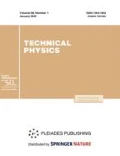Abstract
Different models of hydrogen thermal desorption peaks have been analyzed. The model of volume-averaged concentration dynamics with a continuum parameter makes it possible to integrally take into consideration the dominance of limiting factors: diffusion and recombination of atoms into desorbing molecules. An analytical symmetry criterion for peaks versus the method of expanding a composed spectrum into a series of Gaussian curves is suggested. Modifications of (i) the Kissinger method to estimate the activation energy of desorption in experiments with several material heating rates and (ii) a procedure for solving the inverse problem of unimodal peak parametrical identification from one heat rate are presented. Comparison with the diffusion model with dynamic boundary conditions has been carried out. It has been shown that local peaks may arise not only because of release of hydrogen atoms with different binding energies captured by volume traps, but also because of interaction between volume and surface processes and heat-induced surface structure modifications. The parameters of deuterium thermal desorption from ISO-880U graphite have been estimated.







Similar content being viewed by others
REFERENCES
Interactions of Hydrogen with Metals, Ed. by A. P. Zakharov (Nauka, Moscow, 1987) [in Russian].
Yu. S. Nechaev, Phys.-Usp. 49 (6), 563 (2006). https://doi.org/10.1070/PU2006v049n06ABEH002424
A. A. Pisarev, I. V. Tsvetkov, E. D. Marenkov, and S. S. Yarko, Hydrogen Pearmeability through Metals (MEPhI, Moscow, 2008) [in Russian].
Hydrogen Isotopes. Fundamental and Applied Studies, Ed. by A. A. Yukhimchuk (Russ. Fed. Nucl. Center, Sarov, 2009) [in Russian].
Fundamentals of Hydrogen Power Engineering, Ed. by V. A. Moshnikov and E. I. Terukov (St. Petersburg Gos. Electrotekh. Univ. “LETI,” St. Petersburg, 2011) [in Russian].
S. Vyazovkin, A. K. Burnham, J. M. Criado, L. A. Pérez-Maqueda, C. Popescu, and N. Sbirrazzuoli, Thermochim. Acta 520 (1–2), 1 (2011). https://doi.org/10.1016/j.tca.2011.03.034
S. Vyazovkin, K. Chrissafis, M. L. Di Lorenzo, N. Koga, M. Pijolat, B. Roduit, N. Sbirrazzuoli, and J. J. Sunol, Thermochim. Acta 590, 1 (2014). https://doi.org/10.1016/j.tca.2014.05.036
M. V. Lototskyy, R. Denys, S. N. Nyamsi, I. Bessa-rabskaia, and V. Yartys, Mater. Today: Proc. 5 (4), 10440 (2018). https://doi.org/10.1016/j.matpr.2017.12.375
F. G. Wei, M. Enomoto, and K. Tsuzaki, Comput. Mater. Sci. 51, 322 (2012). https://doi.org/10.1016/j.commatsci.2011.07.009
R. Silverstein, D. Eliezer, and E. Tal-Gutelmacher, J. Alloys Compd. 747, 511 (2018). https://doi.org/10.1016/j.jallcom.2018.03.066
E. A. Denisov, T. N. Kompaniets, A. A. Yukhimchuk, I. E. Boitsov, and I. L. Malkov, Tech. Phys. 58 (6), 779 (2013). https://doi.org/10.1134/S1063784213060091
E. A. Hodille, L. B. Begrambekov, J. Y. Pascal, O. Saidi, J. M. Layet, B. Pégourié, and C. Grisolia, Int. J. Hydrogen Energy 39 (35), 20054 (2014). https://doi.org/10.1016/j.ijhydene.2014.09.027
L. B. Begrambekov, A. E. Evsin, A. V. Grunin, A. I. Gumarov, A. S. Kaplevsky, N. F. Kashapov, A. G. Luchkin, I. R. Vakhitov, I. V. Yanilkin, and L. R. Tagirov, Int. J. Hydrogen Energy 44 (31), 17154 (2019). https://doi.org/10.1016/j.ijhydene.2019.04.198
F. J. Castro and G. Meyer, J. Alloys Compd. 330–332, 59 (2002). https://doi.org/10.1016/S0925-8388(01)01625-5
E. A. Evard, I. E. Gabis, and V. A. Yartys, Int. J. Hydrogen Energy 35 (17), 9060 (2010). https://doi.org/10.1016/j.ijhydene.2010.05.092
A. Rokhmanenkov and A. Yanilkin, Int. J. Hydrogen Energy 44 (55), 29132 (2019). https://doi.org/10.1016/j.ijhydene.2019.03.237
T. L. Murashkina, M. S. Syrtanov, R. S. Laptev, and A. M. Lider, Int. J. Hydrogen Energy 44 (13), 6709 (2019). https://doi.org/10.1016/j.ijhydene.2019.01.150
N. I. Rodchenkova and Yu. V. Zaika, Int. J. Hydrogen Energy 36 (1), 1239 (2011). https://doi.org/10.1016/j.ijhydene.2010.06.121
Yu. V. Zaika and E. K. Kostikova, Adv. Mater. Sci. Appl. 3 (3), 120 (2014). https://doi.org/10.5963/AMSA0303003
Yu. V. Zaika and E. K. Kostikova, Int. J. Hydrogen Energy 42 (1), 4005 (2017). https://doi.org/10.1016/j.ijhydene.2016.10.104
E. Legrand, A. Oudriss, C. Savall, J. Bouhattate, and X. Feaugas, Int. J. Hydrogen Energy 40 (6), 2871 (2015). https://doi.org/10.1016/j.ijhydene.2014.12.069
Yu. S. Nechaev, N. M. Alexandrova, N. A. Shurygina, A. O. Cheretaeva, E. K. Kostikova, and A. Öchsner, J. Nucl. Mater. 535, 152162 (2020). https://doi.org/10.1016/j.jnucmat.2020.152162
Yu. S. Nechaev, N. M. Alexandrova, O. S. Cheretaeva, V. L. Kuznetsov, A. Öchner, E. K. Kostikova, and Yu. V. Zaika, Int. J. Hydrogen Energy 45 (46), 25030 (2020). https://doi.org/10.1016/j.ijhydene.2020.06.242
P. G. Shewmon, Diffusion in Solids (McGraw-Hill, New York, 1963).
H. Atsumi and Y. Kondo, Fusion Eng. Des. 131, 49 (2018). https://doi.org/10.1016/j.fusengdes.2018.04
H. Atsumi, Y. Takemura, T. Miyabe, T. Konishi, T. Tanabe, and T. Shikama, J. Nucl. Mater. 442, S746 (2013). https://doi.org/10.1016/j.jnucmat.2013.03.041
Funding
This study was financially supported by the Russian Foundation for Basic Research, grant no. 18-29-19149 mk.
Author information
Authors and Affiliations
Corresponding author
Ethics declarations
The authors declare that they have no conflict of interest.
Additional information
Translated by V. Isaakyan
Rights and permissions
About this article
Cite this article
Zaika, Y.V., Kostikova, E.K. & Nechaev, Y.S. Peaks of Hydrogen Thermal Desorption: Simulation and Interpretation. Tech. Phys. 66, 210–220 (2021). https://doi.org/10.1134/S1063784221020250
Received:
Revised:
Accepted:
Published:
Issue Date:
DOI: https://doi.org/10.1134/S1063784221020250




